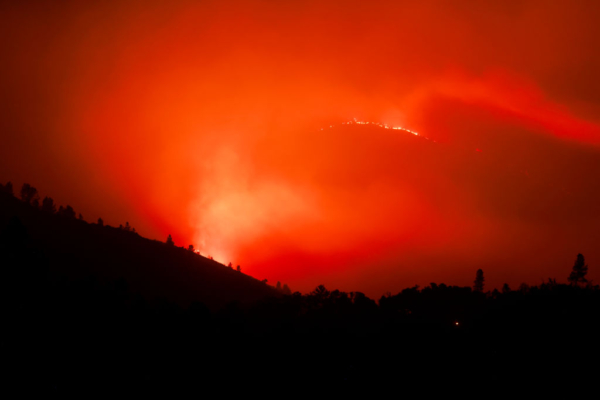This week, strong winds and lightning have sparked and fueled wildfires in the Northwestern Pacific region. On Friday, July 26th, wildfires rapidly spread near the border of Oregon and Idaho in the United States.
According to Reuters, authorities stated that the Durkee wildfire near Huntington, Oregon, located about 100 miles north of Boise, Idaho, has engulfed 600 square miles (1,553 square kilometers) of land, exceeding the size of more than half of Rhode Island’s land area. Several towns are currently under threat from the fire.
The wildfire, ignited by lightning on July 17th, is being driven by gusts up to 60 mph (97 km/h), blowing flames through shrubs, forests, and pastures, resulting in the death of hundreds of cattle. Officials mentioned that as of Friday, the wildfire was only 20% contained.
Meteorologist Marc Chenard from the National Weather Service in the United States mentioned that though the chance of rain next week is zero, the wind intensity has decreased, and cooler weather is expected. “Hopefully, this will allow firefighters to catch a breath,” he said.
The Northwest Coordination Center in Portland, Oregon, reported that as of Thursday this week, wildfires in Oregon have consumed nearly 1 million acres (405,000 hectares) of land, while neighboring Washington state has had 125,900 acres of land destroyed.
Carol Connolly, a spokesperson for the organization, stated that these figures are expected to increase. “Oregon has 54 large wildfires that are not yet under control,” she said.
According to statistics from CBS affiliate KOIN in 2020, Oregon experienced its most severe wildfire outbreak, burning over 1.14 million acres of land.
In California, an arson suspect is believed to have triggered the “Park Fire” in Butte County, located about 100 miles northeast of Sacramento, forcing over 4,000 residents to evacuate. On Thursday, a suspect was arrested for allegedly pushing a burning vehicle into a ditch.
According to the California Department of Forestry and Fire Protection report, the wildfire rapidly spread out of control, expanding overnight from 125,000 acres on Thursday to 164,200 acres early Friday morning.
Fire Captain Dan Collins stated, “The biggest challenge this fire presents is how to access the site. The terrain here is steep, with barely any roads. Our personnel and equipment have a hard time reaching the fire lines.”
Forecasters warned that wind speeds on Friday and throughout the weekend would reach up to 30 mph (48 km/h).
Simultaneously, smoke from wildfires in Western Canada and the Northwestern Pacific region has led to hazy skies and unhealthy air from the Rocky Mountains to Minneapolis and as far east as Detroit.
According to the IQAir organization monitoring global air pollution, Denver had the worst air quality in the United States on Friday.
Smoke from wildfires in Alberta’s Jasper National Park in the mountains has entered the central and eastern United States, affecting much of the region. On Monday, Jasper Town, which attracts over 2 million visitors annually, was evacuated, impacting 10,000 residents and 15,000 park visitors. Officials mentioned that as of late Thursday night, the wildfire had consumed over 89,000 acres of land, with up to half of the town’s structures potentially damaged or destroyed.
Videos circulating on social media showed entire streets in Alberta’s province leveled by the raging wildfire, trees charred, cars reduced to metal skeletons, and buildings and businesses reduced to rubble.

